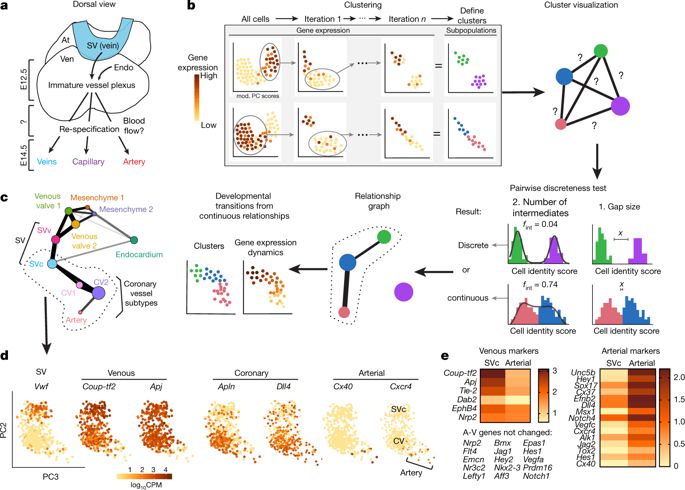Our official English website, www.x-mol.net, welcomes your feedback! (Note: you will need to create a separate account there.)
Single-cell analysis of early progenitor cells that build coronary arteries
Nature ( IF 64.8 ) Pub Date : 2018-07-01 , DOI: 10.1038/s41586-018-0288-7 Tianying Su 1 , Geoff Stanley 2 , Rahul Sinha 3 , Gaetano D'Amato 1 , Soumya Das 1 , Siyeon Rhee 1 , Andrew H Chang 1 , Aruna Poduri 1 , Brian Raftrey 1 , Thanh Theresa Dinh 4, 5 , Walter A Roper 4, 5 , Guang Li 6 , Kelsey E Quinn 7 , Kathleen M Caron 7 , Sean Wu 3, 6, 8 , Lucile Miquerol 9 , Eugene C Butcher 4, 5 , Irving Weissman 3 , Stephen Quake 10, 11 , Kristy Red-Horse 1
Nature ( IF 64.8 ) Pub Date : 2018-07-01 , DOI: 10.1038/s41586-018-0288-7 Tianying Su 1 , Geoff Stanley 2 , Rahul Sinha 3 , Gaetano D'Amato 1 , Soumya Das 1 , Siyeon Rhee 1 , Andrew H Chang 1 , Aruna Poduri 1 , Brian Raftrey 1 , Thanh Theresa Dinh 4, 5 , Walter A Roper 4, 5 , Guang Li 6 , Kelsey E Quinn 7 , Kathleen M Caron 7 , Sean Wu 3, 6, 8 , Lucile Miquerol 9 , Eugene C Butcher 4, 5 , Irving Weissman 3 , Stephen Quake 10, 11 , Kristy Red-Horse 1
Affiliation

|
Arteries and veins are specified by antagonistic transcriptional programs. However, during development and regeneration, new arteries can arise from pre-existing veins through a poorly understood process of cell fate conversion. Here, using single-cell RNA sequencing and mouse genetics, we show that vein cells of the developing heart undergo an early cell fate switch to create a pre-artery population that subsequently builds coronary arteries. Vein cells underwent a gradual and simultaneous switch from venous to arterial fate before a subset of cells crossed a transcriptional threshold into the pre-artery state. Before the onset of coronary blood flow, pre-artery cells appeared in the immature vessel plexus, expressed mature artery markers, and decreased cell cycling. The vein-specifying transcription factor COUP-TF2 (also known as NR2F2) prevented plexus cells from overcoming the pre-artery threshold by inducing cell cycle genes. Thus, vein-derived coronary arteries are built by pre-artery cells that can differentiate independently of blood flow upon the release of inhibition mediated by COUP-TF2 and cell cycle factors.During development, new arteries can arise from pre-existing veins; the cell fate switch involved occurs gradually and before the onset of blood flow in mouse embryo hearts.
中文翻译:

构建冠状动脉的早期祖细胞的单细胞分析
动脉和静脉是由拮抗转录程序指定的。然而,在发育和再生过程中,新的动脉可能会通过细胞命运转换的一个鲜为人知的过程从预先存在的静脉中产生。在这里,利用单细胞 RNA 测序和小鼠遗传学,我们证明发育中心脏的静脉细胞经历早期细胞命运转换,形成动脉前细胞群,随后形成冠状动脉。在一部分细胞跨越转录阈值进入动脉前状态之前,静脉细胞经历了从静脉到动脉命运的逐渐且同时的转变。在冠状动脉血流开始之前,未成熟的血管丛中出现前动脉细胞,表达成熟的动脉标志物,细胞周期减少。静脉特异性转录因子 COUP-TF2(也称为 NR2F2)通过诱导细胞周期基因来阻止神经丛细胞克服动脉前阈值。因此,静脉来源的冠状动脉是由前动脉细胞构建的,这些细胞可以在释放 COUP-TF2 和细胞周期因子介导的抑制作用后独立于血流进行分化。在发育过程中,新的动脉可以从先前存在的静脉中产生; 所涉及的细胞命运转换在小鼠胚胎心脏中的血流开始之前逐渐发生。
更新日期:2018-07-01
中文翻译:

构建冠状动脉的早期祖细胞的单细胞分析
动脉和静脉是由拮抗转录程序指定的。然而,在发育和再生过程中,新的动脉可能会通过细胞命运转换的一个鲜为人知的过程从预先存在的静脉中产生。在这里,利用单细胞 RNA 测序和小鼠遗传学,我们证明发育中心脏的静脉细胞经历早期细胞命运转换,形成动脉前细胞群,随后形成冠状动脉。在一部分细胞跨越转录阈值进入动脉前状态之前,静脉细胞经历了从静脉到动脉命运的逐渐且同时的转变。在冠状动脉血流开始之前,未成熟的血管丛中出现前动脉细胞,表达成熟的动脉标志物,细胞周期减少。静脉特异性转录因子 COUP-TF2(也称为 NR2F2)通过诱导细胞周期基因来阻止神经丛细胞克服动脉前阈值。因此,静脉来源的冠状动脉是由前动脉细胞构建的,这些细胞可以在释放 COUP-TF2 和细胞周期因子介导的抑制作用后独立于血流进行分化。在发育过程中,新的动脉可以从先前存在的静脉中产生; 所涉及的细胞命运转换在小鼠胚胎心脏中的血流开始之前逐渐发生。



























 京公网安备 11010802027423号
京公网安备 11010802027423号